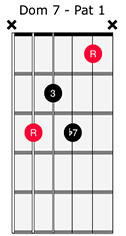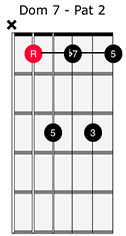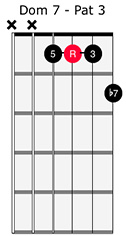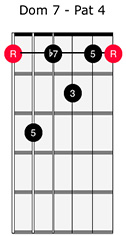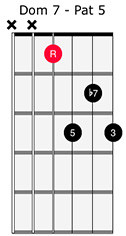7th Chord Comping

Attached are the 5 patterns of the dominant 7th chord, which contains the intervals:
1 3 5 b7
When comping on V7 chords, do your best to stay out of the way of the bass line, shuffle, or any other arrangements in the mix. So - little strikes, arpeggiations, and embellishments go a long way to filling up the sound without muddying it up too much.
If you don’t have other guitar parts playing on the tune, chord comping is a great first part alternative to the shuffle and it has it’s own specific sound.
OTHER GREAT COMPING OPTION: Diminished triads and double stops
Without going way out in to music theory land - Dom 7 chords are 4 note chords: Root, Major 3rd, 5th and b7.
If you play just the top three notes in the chord (omit the root) you are left with a diminished triad. For example: G7 is made up of G, B, D and F. If you only play the top 3 notes, you get B, D and F. This equals B diminished.
Whenever you play a diminished triad, you are implying the Dominant 7 chord a major 3rd below the root.
So again, for example:
If you play a B dim triad you are “sounding” G7
If you play a C# dim triad you are “sounding” A7
Get it?
I have listed the common diminished triad shapes as well as the common full dominant 7 chord shapes In the PDF. Please download and see how they sound.
One more thing: as mentioned in the video, if you are interested in playing a “thinner” or less busy part, focusing on the 3rds and 7ths of the Dom 7 chord shapes will give you double stops that also imply the V7 chord.
Have some fun messing around comping on the blues!
